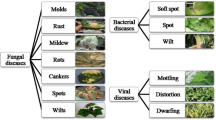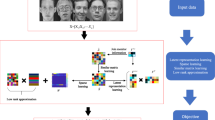Abstract
In this paper, we propose a novel plant identification method based on multipath sparse coding using SIFT features, which avoids the need of feature engineering and the reliance on botanical taxonomy. In particular, the proposed method uses five paths to model the shape and texture features of plant images, and at each path it learns the dictionaries with different sizes using hierarchical sparse coding. Finally, we apply the learned representation for plant identification using linear SVM for classification. We evaluate the proposed method on several plant datasets and find that multi-organ is more informative than single organ for botanist. Experimental results also validate that the proposed method outperforms the state-of-the-art methods.









Similar content being viewed by others
Notes
can be downloaded from http://www.vlfeat.org
References
Belhumeur P, Chen D, Feiner S, Jacobs D, Kress W, Ling H, Lopez I, Ramamoorthi R, Sheorey S, White S, Zhang L (2008) Searching the world’s herbaria: a system for visual identification of plant species. In: European Conference on Computer Vision (ECCV), p 116–129
Bo L, Ren X, Fox D (2013) Multipath sparse coding using hierarchical matching pursuit. In: CVPR
Boureau Y, Bach F, LeCun Y, Ponce J (2010) Learning mid-level features for recognition. In: CVPR
Caballero C, Aranda MC (2010) Plant species identification using leaf image retrieval. In: ACM International Conference on Image and Video Retrieval (CIVR), p 327–334
Du JX, Wang XF, Hang GJ (2007) Leaf shape based plant species recognition. Appl Math Comput 185(2):883–893
Fiel S, Sablatnig R (2011) Automated identification of tree species from images of the bark, leaves and needles. 16th Computer Vision Winter Workshop, Austria
Goëau H, Bonnet P, Barbe J, Bakic V, Joly A, Molino J-F (2012) Multi-organ plant identification. In: the Proceedings of the 1st ACM international workshop on Multimedia analysis for ecological data. p 41–44
Goëau H, Bonnet P, Joly A (2015) LifeCLEF plant identification task
Guru DS, Sharath YH, Manjunath S (2010) Texture features and KNN in classification of flower images. IJCA Special Issue on Recent Trends in Image Processing and Pattern Recognition
Han J, Sun L, Hu X, Han J, Shao L (2014) Spatial and temporal visual attention prediction in videos using eye movement data. Neurocomputing 145:140–153
Han J, Wang D, Shao L, Qian X, Cheng G, Han J (2014) Image visual attention computation and application via the learning of object attributes. Mach Vis Appl 25(7):1671–1683
Hsiao JK, Kang LW, Chang CL, Lin CY (2014) Learning sparse representation for leaf image recognition. In: ICCE
Hsiao JK, Kang LW, Chang CL, Lin CY (2014) Comparative study of leaf image recognition with a novel learning-based approach. Science and Information Conference. London, p 389–393
Kim S-J, Kim B-W, Kim D-P (2011) Tree recognition for landscape using by combination of features of its leaf, flower and bark. SICE Annual Conference. Tokyo, p 1147–1151
Kulkarni T, Uke NJ (2014) Implementation of image based flower classification system. Int J Comput Sci Bus Inform (IJCSBI) 13(1):35–44
Kumar N, Belhumeur PN, Biswas A, Jacobs DW, Kress WJ, Lopez IC, Soares JVB (2012) Leafsnap: a computer vision system for automatic plant species identification. ECCV, p 502–516
Lazebnik S, Schmid C, Ponce J (2006) Beyond bags of features: spatial pyramid matching for recognizing natural scene categories. In: CVPR
Lee K-B, Hong K-S (2013) An implementation of leaf recognition system using leaf vein and shape. Int J Bio-Sci Bio-Technol 5:57–65
Lowe DG (2004) Distinctive image features from scale-invariant keypoints. Int J Comput Vis (IJCV) 60(2):91–110
Mabrouk AB, Najjar A, Zagrouba E (2014) Image flower recognition based on a new method for color feature extraction. International Conference on Computer Vision Theory and Application (VISAPP), p 201-206
Metre V, Ghorpade J (2013) An overview of the research on texture based plant leaf classification. IJCSN Int J Comput Sci Netw 2(3)
Mouine S, Yahiaoui I, Erroust-Blondet A, Joyeux L, Selmi S, Goëau H (2013) An android application for leaf-based plant identification. Proc. ACM Int. Conf. Multimedia Retrieval
Mouine S, Yahiaoui I, Verroust-Blondet A (2013) Advanced shape context for plant species identification using leaf image retrieval. In: Proceedings of the second ACM International Conference on Multimedia Retrieval. ACM, p 49
Nilsback M-E, Zisserman A. Automated flower classification over a large number of classes. In: Indian Conference on Computer Vision, Graphics and Image Processing, p 722–729
Pallavi P, Veena Devi VS (2014) Leaf recognition based on feature extraction and zernike moments. International Conference On Advances in Computer & Communication Engineering (ACCE), p 67–73
Patel HN, Dr. Jain RK, Dr. Joshi MV (2011) Fruit detection using improved multiple features based algorithm. Int J Comput Appl 13(2)
Peng P, Shao L, Han J, Han J (2015) Saliency-aware image-to-class distances for image classification. Neurocomputing 166:337–345
Song Y, Glasbey CA, Horgan GW, Polder G, Dieleman JA, Van der Heijden GWAM (2014) Automatic fruit recognition and counting from multiple images. Biosyst Eng 118:203–215
Spams toolbox. http://spams-devel.gforge.inria.fr/
Tang J, Shao L, Li X (2014) Efficient dictionary learning for visual categorization. Comput Vis Image Underst 124:91–98
Wang Z, Chi Z, Feng D (2003) Shape based leaf image retrieval. IEE Proc Vis Image Signal Process 150(1):34–43
Wang X, Huang D, Dua J, Xu H, Heutte L (2008) Classification of plant leaf images with complicated background. Appl Math Comput 205:916–926
Wang Z, Lu B, Chi Z, Feng D (2011) Leaf image classification with shape context and SIFT descriptors. In: Digital image computing: techniques and applications (DICTA), p 650–654
Wang J, Yang J, Yu K, Lv F, Huang T, Guo Y (2010) Locality-constrained linear coding for image classification. In: CVPR
Wilf P, Zhang S, Chikkerur S, Little S, Wing S, Serre T (2016) Computer vision cracks the leaf code. PNAS, 113(12): 3305-3310
Xiao XY, Hu R, Zhang SW, Wang XF (2010) HOG based approach for leaf classification, vol. 6216 of Lecture Notes in Computer Science, book section 19. Springer Berlin Heidelberg, p 149–155
Yang J, Yu K, Gong Y, Huang T (2009) Linear spatial pyramid matching using sparse coding for image classification. In: CVPR
Yu K, Lin Y, Lafferty J (2011) Learning image representations from the pixel level via hierarchical sparse coding. In: CVPR
Zhang B, Ji S, Li L, Zhang S, Yang W. Sparsity analysis versus sparse representation classifier. Neuro Comput, accepted. doi:10.1016/j.neucom.2015.06.052
Zhang B, Perina A, Murino V, Del Bue A (2015) Sparse representation classification with manifold constraints transfer. CVPR, p 4557–4565
Zhang S, Yao H, Sun X, Lu X (2013) Sparse coding based visual tracking: Review and experimental comparison. Pattern Recogn 46(7):1772–1788
Zhang S, Zhou H, Jiang F, Li X (2015) Robust visual tracking using structurally random projection and weighted least squares. IEEE Trans Circuits Syst Video Technol 25(11):1749–1760
Acknowledgements
This work is supported in part by the national key R&D program of China (2015BAH52F03), the Natural Science Foundation of China (No. 61300111), Hubei Provincial Natural Science Foundation (NO.2014CFB659) and selfdetermined research funds of CCNU from the colleges’ basic research and operation of MOE (No.CCNU15A05023).
Author information
Authors and Affiliations
Corresponding author
Rights and permissions
About this article
Cite this article
Zhu, H., Huang, X., Zhang, S. et al. Plant identification via multipath sparse coding. Multimed Tools Appl 76, 4599–4615 (2017). https://doi.org/10.1007/s11042-016-3538-4
Received:
Revised:
Accepted:
Published:
Issue Date:
DOI: https://doi.org/10.1007/s11042-016-3538-4




